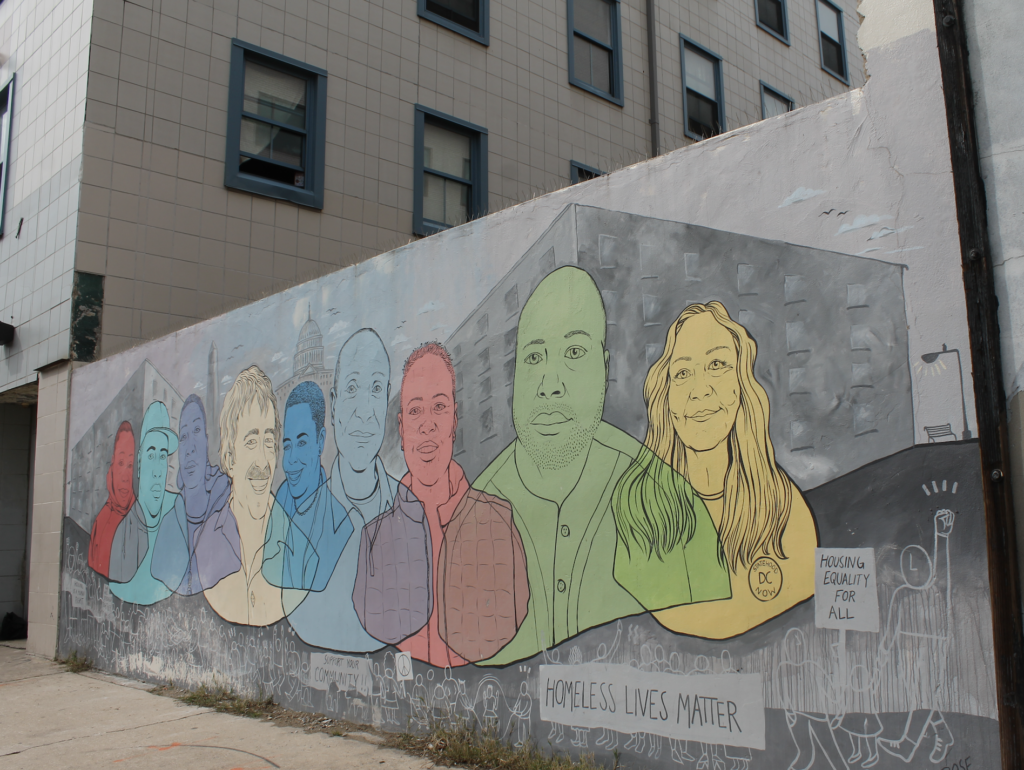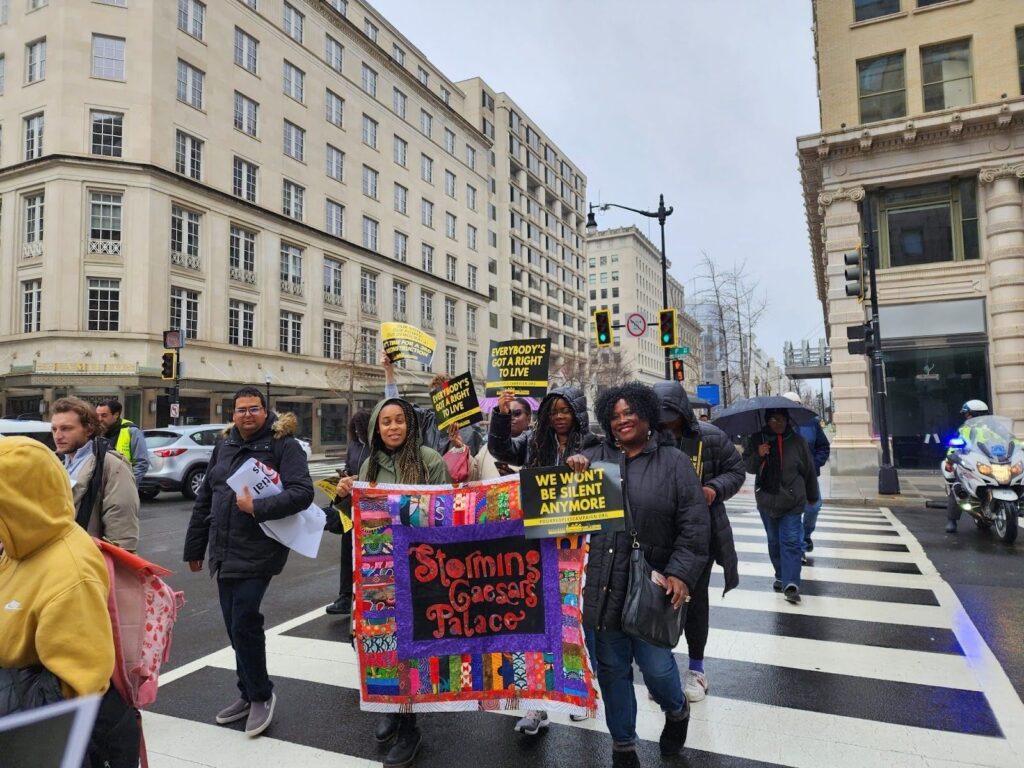Starting off as an anti-war and peace movement in the 1970s, the Community for Creative Non-Violence (CCNV) transformed the rights of the homeless community across the country. Through grass-roots activism, hunger strikes, and working to have policymakers and Hollywood come together to fight for their movement, CCNV brought homelessness to the forefront of American politics in the ‘80s.
For over 40 years, CCNV has served thousands of guests. It is the largest shelter in the District, with beds for just over 1,300 people, and one of the largest in the country. Shelter, food, medical services, laundry, and educational programs are all available on-site. The organization was once described as a “model shelter” by the Reagan administration for other cities to look to their success and follow in their footsteps. Though the nonprofit faces complaints similar to D.C.’s city-run shelters: bedbugs, theft, violence, and staff abuse.
However, CCNV finds itself at a crossroads today, suing the federal government over the rights to the property. On Jan. 3, 2021, CCNV filed a lawsuit against the Department of Health and Human Services and the General Service Administration, claiming that the agencies had violated their 1993 deed agreement that conditionally gave the property to CCNV and failed to act in good-faith with their commitments outlined in the deed agreement. The suit seeks to have the property title granted to the CCNV and monetary compensation of at least $100,000 for damages in the form of lost opportunities and increased development costs, as well as damage to CCNV’s title.
In 1986, the federal government deeded the building to the District of Columbia for a limited time to be used as a homeless shelter and allocated funds for repair and renovation. Ownership of a much smaller building and 0.84 acres of land located immediately behind what is now the shelter was transferred to CCNV in 1993. The time-limited deed is set to expire in July 2021, sparking conflict between CCNV and the government on what will happen to the property.
Until the expiration of the deed agreement in July, the District will maintain some control over the shelter, through the conditions in the deed. When the deed expires, the CCNV will outright own the property, leaving the federal government with no legal claims to the land.
Broken promises
Conflict with the government is no new burden to CCNV. Throughout the 1980s, CCNV was in an ongoing battle with the Reagan administration over renovating what was once a decrepit building, and fighting for the rights to their property to keep their essential services running.
The building was formerly a downtown campus of the University of the District of Columbia but had sat vacant since 1980 when the college relocated to its current campus in Van Ness.
“CCNV was given permission to start the shelter at that building in 1983, so for the winters of ‘83 and ‘84, CCNV began operating the Second and E shelter,” said Jerry Jones, a former CCNV employee who is now the national field director for the National Alliance to End Homelessness. “In 1984, they realized that the building itself was pretty much uninhabitable.”
Mitch Snyder, the leader of CCNV at the time, began a campaign to improve the conditions of the property, arguing that it was the government’s responsibility to renovate the building. In the summer of 1984, Snyder along with 11 other CCNV activists embarked on a hunger strike, with Snyder fasting for 51 days, nearing death. On Snyder’s last day of fasting and the eve of election night, President Reagan agreed to refurbish the building, committing to build a kitchen area, lockers, a laundry room, a first-aid station and to repair the sprinkler system in order to make the building fire safe.
Despite promises from the Reagan administration, months went by and no improvements had been made. After months of negotiations over what the renovations would look like and with no compromise in sight, the federal government withdrew their agreement with CCNV and made plans to close the shelter. CCNV immediately filed suit in the District court to keep the shelter open but the court reaffirmed the decision to close CCNV. In an attempt to find alternative housing for CCNV residents, the government had agreed to fund the D.C. Coalition for the Homeless to operate a new shelter in Anacostia, 10 miles away from CCNV.
“The dynamic in the 1980s very much was about the sense that this was prime real estate. The shelter is in probably one of the most densely populated areas of downtown, and this is true even today,” Jones said.
Controversy stirred among both CCNV advocates and Anacostia residents over the site of the new shelter, sparking protests against its opening. In December 1985, CCNV was sent a U.S. Marshal Service eviction notice, but 600 residents refused to leave. Eventually, the Reagan administration decided against the eviction of CCNV.
In November of 1986, members of CCNV lived outside on the grounds of the U.S. Capitol during a five-month campaign for passage of the Stewart B. McKinney Homeless Assistance Act, which authorized the use of underutilized public buildings and real property to assist the homeless and to make surplus personal property available to nonprofit agencies. The law was passed in April of 1987, providing $1 billion in aid to unsheltered individuals.
“During the 1980s people were not accustomed to seeing folks sleeping on the grates and the scale of folks in utter destitution, panhandling in public spaces,” Jones said. “Mitch and CCNV were really in the center of what became a very consequential counter movement to budget cuts and ultimately the rejection of what was Reaganomics in the 1980s and a recognition that we do need a safety net and that we do need to invest in programs and then sort of build back into the budgets for affordable housing and spending on homelessness. That legacy continues today.”

In an attempt to push the government to finally renovate the shelter, Mitch and other activists began another hunger strike in the fall of 1988. In 1988, renovations finally occurred, costing $14 million and creating the largest shelter in the U.S. at the time.
Envisioning a new homeless services center
In 2018, 30 years after the last renovation, CNNV approached HHS regarding the deteriorating physical conditions of the shelter, seeking financing for a redevelopment project. “There are some ongoing maintenance issues,” said Eric Sheptock, an advocate for people experiencing homelessness and resident of CCNV. “ The plumbing here is the main one, I see the light spots in the ceiling tile, when there’s a leak above the ceiling tiles it turns the ceiling tile brown.”
“If you look outside and you’ll see a bunch of rats and I mean generations, generations and generations, all kinds of great, great, great great rats all out here, and it is nasty,” said Aeshia Allen, former resident of CCNV.
With the upcoming expiration of the deed agreement that would result in CCNV owning the property, CCNV sought approval to convert the property for the creation of a new homeless-services center to address the condition of the building. Instead of agreeing to improve the conditions of the building, HHS claimed that the property was being used in an “unapproved” manner.
HHS claims that D.C. Central Kitchen, an organization that provides culinary job training for individuals facing high barriers to employment and provides meals for CCNV residents, is using CCNV’s parking lot. “D.C. Central Kitchen has used the parking lot where they’ve loaded the food up,” said Sheptock. “For the entirety of the 30 years, the rule was that if the property is not in use for health purposes for more than 12 months, the federal government can take it back”
HHS and CCNV have been debating over the use of the property since March 2019, with HHS using the alleged misuse of the property by D.C. Central Kitchen as leverage in their claim to the property. In October, the HHS, working with GSA, took action to reclaim the property through a “notice of revert,” arguing that CCNV was violating its terms of use outlined in the 1993 deed agreement, citing that some of D.C. Central Kitchen’s services were not eligible programs in accordance with conditions of the deed.
However, on Dec. 16, 2020, D.C. Central Kitchen announced that they will be moving to a new facility, located in the Buzzard Point neighborhood along the Southwest Waterfront. In a press release, D.C. Central kitchen stated that the new facility will allow them to triple their capacity. “I don’t know exactly why they’re moving,” said Sheptock. “I would imagine that maybe the maintenance issues inside of the shelter building, where the kitchen is located, might be the reason that they’re moving. I’m sure that these plumbing problems have probably made things hard on the kitchen.” D.C. Central Kitchen declined to comment on the suit, but stated that “D.C. Central Kitchen is not involved in any way with this lawsuit.” The organization added that they have “long-standing partnerships with both CCNV and the Department of Human Services” and that they “hope to see a productive, positive resolution that addresses the root causes of homelessness in our community.”
On March 29, 2021, HHS filed a response to CCNV’s lawsuit, stating that CCNV had breached the deed agreement, that the United States is entitled to the property, and CCNV should be ejected from the property. The response further indicates that HHS denies that CCNV is entitled to the requested relief or any relief, and included a suggested order for the judge to dismiss the case.

“The fight for space at 2nd and D continues as it has for three and half decades,” Jones said. “And the history of that building has been this attempt to hold on to a little bit of land for those who have virtually nothing to call their own”
In CCNV’s suit, the organization argues that it has had the stability of its operations jeopardized, threatening the safety and wellbeing of the 1,000 residents they host nightly. If HHS and GSA are successful in dispossessing CCNV from the property, the city will have to make plans for all of the residents that call this shelter home.
“There’s been this sort of epic struggle over this small amount of space less than two acres total for the building and the rear of the site,” Jones said, “that’s the only place for up to 1,000 people on any given night who have nowhere else to lay their heads.”








